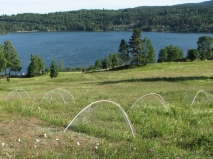Experimental pollinator decline affects plant reproduction and is mediated by plant mating system
DOI:
https://doi.org/10.26786/1920-7603(2013)5Abstract
There is growing concern that current pollinator decline will affect the reproduction of plant species, potentially driving a decline in plant population densities. We experimentally tested whether a reduction in flower visitation caused a reduction in fertilization rate in several species, and whether any reduction in fecundity of species depends on their degree of reproductive dependence on pollinators and their attractiveness for pollinators. We recorded visitation rate, fertilization rate, seed weight, flower size and density of nineteen insect-pollinated perennial herbs inside thirty 2 x 2 m dome-shaped cages covered with fishnet (experimental plots) and in thirty control plots in a Norwegian hay meadow. We used a bagging experiment to estimate the ability of the study species to produce seeds in the absence of pollinators. The visitation rate for fifteen of nineteen study species was lower inside cages than outside and only three of the fifteen species showed significantly reduced fertilization rates in the experimental plots. The magnitude of reduction in fertilization rate was positively related to the degree of pollinator dependence, but not to their attractiveness for pollinators or to the reduction in visitation rate. Seed weight was not affected by the experiment. The lack of an overall effect of reduced pollinator visitation on fertilization rate suggests that some species may be robust to a pollinator decline that could increase pollen limitation on plant reproduction. Our results suggest that species with greater pollinator dependence are more vulnerable to pollinator loss.

Downloads
Published
How to Cite
Issue
Section
License
Copyright (c) 2013 Rebekka Lundgren, Amparo Lazáro, Ørjan Totland

This work is licensed under a Creative Commons Attribution 4.0 International License.











